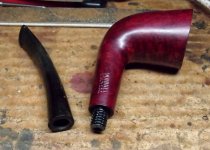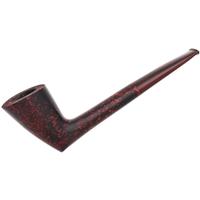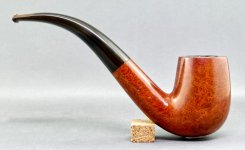That's good information and observations, George. Would you mind posting a few photos of the "black dots"? I'd like to see them, and I think it'd be very instructive for others to see.
I was referring to the making-black mechanism being a "real thing".
I'd always assumed that Dunhill's QA check following the drill & fill dot procedure was a look down the airway to see if they'd gone too deep, or sliding a flexy rod if the stem was bent.
Apparently not, at least sometimes.
The following pics are from a tenon replacement project where the hole to accept the new Delrin tenon came within a millimeter of a rod-across-the-airway, exposing it clearly.
I'd run into "airway blocking dots" before, many which had become discolored, but couldn't take photos to prove it. (That would have taken some sort of micro-snake camera lens with a light on the end of it).
In this case, though, it was simply happenstance. The pipe's owner had thought the pipe's draw was a bit stiff, but since he could get a cleaner past the "post" with a bit of twisting and effort, thought no more about it. The deep "new tenon holding hole" shined the light of day on the situation, though.
Expecting nothing, I didn't even see it at first. I just kept digging at a tight ball of black cleaner fuzz with an assortment of things, wondering why it wouldn't come out, then finally managed using the end of a drill bit. The dig/scrape of the bit exposed some white and further cleaning with alcohol and a bristle brush told the tale.
Had I not chewed half the rod away digging at the sticky-clingy fuzzball, it would have been a dead-straight vertical pillar across the airway instead of a snaggly-looking stub, but the story told was clear.
The moral? Never trust a factory worker with a drill press on Fridays after lunch.


Last edited:



























